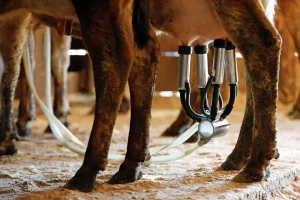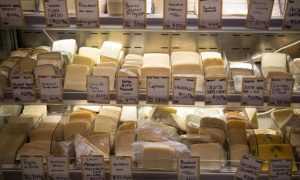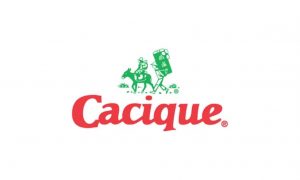
Cheeses are part of our traditions, no matter where we come from, in all regions and cultures, except in some parts of Asia, where their scarce presence is due to a lactose intolerance that remained in their population, which rejected dairy consumption from the beginning and could not adapt their genetics; however, in China, the consumption of dairy products is currently increasing significantly.
The first cheese-making industry was opened in Switzerland in 1815, but it was in the United States where large-scale production began. The bacteria for its production were obtained from the environment until, around the turn of the century, science began to create pure microbes, giving way to the production of processed cheeses.
Industrial cheese production surpassed traditional cheese production in World War II, and factories became the source of most cheeses in America and Europe.
There are so many cheeses that it is impossible to make a single classification. They are defined by characteristics such as aging, or curing, the origin of the milk used, their texture or their fat content. In places like Spain and Italy, we find more than 100 varieties, but today I invite you to take a trip around the world in 80 cheeses:
?? Egypt | Domiati Soft and salty white cheese, produced mainly in Egypt, but also in Sudan and other Middle Eastern countries.
?? Ethiopia | Ayibe A soft, brittle cottage cheese. It has little flavor on its own and is usually served as an accompaniment to soften highly spiced food.
?? South Africa | Bokmakiri A soft cheese made from goat’s milk.
?? Bangladesh| Chhena Fresh unripened cheese made from water buffalo milk. It has a moist, crumbly form like farmer cheese or paneer, and is used to make desserts such as rasagula.
?? China | In Chinese culture, dairy is not a protagonist, however, in peripheral regions such as Tibet or Yunnan, a strong cheese tradition can be found: Rushan Made from cow’s milk, it is flat and has a leathery texture. It is usually served grilled.
?? Philippines | Kesong puti Soft white cheese similar to cottage cheese, it is made with carabao milk, salt and rennet. Its texture is smooth and its flavor is slightly salty.
?? India | Paneer Common in South Asia, it is an uncured sour cheese. It is made by heating milk with lemon or other sour food.
?? Japan | Sakura Creamy in texture and white in color.
?? Mongolia | Byaslag Prepared with cow or yak milk, its curd is clumsy and its taste bitter.
?? Nepal | Chhurpi Made with yak milk, it is a smoked cheese.
?? Israel| Akkawi Usually made with cow’s milk but, also with goat’s or sheep’s milk.
?? Bulgaria| Kashkawal Yellow cheese made with sheep’s milk.
?? Lebanon | Shanklish Spherical in shape, approximately 6 centimeters in diameter, it is usually coated with spices such as zataar or aleppo pepper.
?? Iran | Lighvan Cheese made with brine, with a bitter taste and covered with holes. It is made with sheep’s milk.
?? Syria | Tresse It is white, semi-soft and elastic, similar to mozzerella. The cheese is properly blended with Mahleb, which is often mixed with black cumin (nigella sativa), anise or caraway seeds. It is usually soaked in brine for several weeks before braiding.
?? Germany | Tilsit Semi-soft, its color is yellow and it is made from pasteurized cow’s milk.
?? Armenia Chechil String cheese originating in Armenia and Anatolia, similar in consistency to mozzarella cheese. It is produced in the form of thick strings rolled into eight-shaped ribbons.
?? Armenia | Motal made from goat’s milk, in the provinces of Gergharkunik and Shirak. A ripening of 35 to 50 days, soft paste and without rind.
?? Austria | Vorarlberger Bergkäse With a grainy rind and brown color, its ripening time is between three and six months.
?? Belgium | Limburger Known for its pungent odor.
?? Belgium | Neteling Of firm soft paste with ash rind, a minimum curing time of 4 to 5 weeks.
?? Bosnia and Herzegovina |Livno After 60 to 66 days, acquires a full flavor with more aging, spicy.
?? Cyprus | Anari Whey cheese, in its simple form its color is chalk-like and its consistency is very soft.
?? Croatia | Škripavac Its name derives from the squeak produced when chewed. It is made with raw cow’s or sheep’s milk.
?? Denmark | Castello Blue Triple cream blue cheese with various molds that give it a slightly spicy flavor.
?? Slovakia | Parenica Semi-hard smoked cheese, without rind. It is produced in spiral braided strips that take the shape of a snail.
?? Spain is a great producer of cheeses, many of which, such as Manchego, achieved international renown. Twenty-six of them have obtained protected designation of origin.
?? Spain ranks second in this cheese ranking as it places three in the list of the best cheeses in the world. Payoyo, typical of Cadiz and made from goat and sheep’s milk;
?? Spain | Idiazábal From sheep, and found in the Basque Country and Navarre.
?? Finland | Leipäjuusto Made from cow colostrum, it can be eaten hot or cold.
?? France is one of the main producers of this food, being an essential feature of its gastronomy. One of them is Reblochon, made with raw cow’s milk from the Abondance, Tarine and Montbéliarde breeds, which owes its curious name (reblochon means in Savoyard something like milking) to a trick of the shepherds to avoid having to give all the milk from the cows as a religious tax.
?? France | Val de Lou From cow’s milk, soft paste, washed rind.
?? Greece | Feta Made from sheep’s or mare’s milk, it is a soft and slightly acid cheese.
?? Georgia | Sulguni With a bitter and moderately salty flavor, it has a leaky texture and its consistency is elastic. Its color varies from white to pale yellow. It is usually served fried to mask its odor.
?? Hungary : Lajta Semi-soft cheese made from cow’s milk. Its interior contains numerous small holes.
?? Ireland | Ardrahan Made from cow’s milk, its texture is soft and its color yellow.
? Iceland | Höfðingi Creamy and soft cheese.
?? Italy | Parmiggiano Reggiano itself is a symbol this country, from raw milk from cows fed with a special diet, depending on its maturation we will find in mouth from caramel, apple, pineapple, banana, chocolate, toffee, spicy and sweet.
? Italy | Parmesan cheese.
?? Provolone cheese and the.
? Mozzarella cheese.
?? | Malta Ġbejna Small round cheese made from sheep’s milk, salt and rennet.
?? Norway is the home of the best cheese in the world. It doesn’t have a great reputation as a cheese country but one of them is in the first place: Ostegarden’s Fanaost, produced by the 12 cows of this farm, is an aged gouda produced in the east of this country.
?? Norway | Jarlsberg Made from cow’s milk, its taste is slightly sweet.
?? Norway | Geitost Brewed with goat’s milk and usually served with a coffee.
?? Norway | Gamalost In Norwegian it means “old cheese”. It is a type of blue cheese, with a strong smell, which will delight lovers of strong cheeses.
?? Netherlands | Gouda Semi-hard cheese made from pasteurized cow’s milk.
?? Poland | Liliput Cow’s cheese cured in brine and mild and delicate flavor.
?? Portugal | Terrincho Semi-soft and oily sheep cheese.
?? United Kingdom according to the British Cheese Chamber, there are over 700 varieties of British cheese. Cheddar, a pressed hard cheese with a pale color and a sour taste, is the most bought and eaten cheese in England and the world.
?? Romania | Telemea Similar to feta and silene, it is usually presented immersed in its own rennet.
?? Russia | Korall Cream cheese made from cow’s milk, with a taste of shrimp.
?? Serbia | Pule Considered the most expensive cheese in the world, it is made with donkey milk from the Balkans.
?? Sweden | Västerbotten Made with cow’s milk, it is similar to Parmesan but more bitter.
?? Switzerland home to approximately 450 cheeses, most of which are made from cow’s milk.
??Turkey | Airas or Kumis Made on the basis of kefir, it was traditionally made with mare’s milk.
?? Turkey | Tulum It is made from raw sheep’s milk that is put to mature in bags made from goat skin (called tulum), where it can remain from 3 months to 2 years, and where it develops its intense aroma and strong flavor.
?? Canada | Oka Originally made by the Trappist monks located in Oka, it has a spicy aroma and mild flavor.
?? United States | Bergenost Norwegian-style triple cream cheese.
?? Mexico | Cotija or añejo Salty cheese with strong aroma and flavor.
?? Argentina | Pategrás Made with cow’s milk, it is the most popular semi-hard cheese in the country.
?? Argentina | Banquete de Tandil Cheese made with cow’s milk, in the Pampena region, semi-hard paste of natural rind, with a minimum maturity of 25 days.
?? Bolivia | Quesillo cochabambino Made with fresh cow’s milk.
?? Brazil | Catupiry Soft, spreadable cheese, with low acidity level.
?? Brasil | Azul do Bosque From goat’s milk, it is semi-soft paste with natural open rind covered with charcoal.
?? Chile | Chanco High fat cheese with a mild acid flavor.
?? Colombia | Costeño White cheese, fresh and soft.
Paraguay | Paraguay It is made from whole cow’s milk, not skimmed. Creamy cheese soft mass and slightly sour taste.
?? Uruguay | Colonia It is a soft cheese with a hard rind, light yellow color and abundant eyes.
?? Venezuela | Guayanés Similar to mozzarella, it is usually used to fill arepas and cachapas.
?? Qatar | Labneh Made from strained and pressed yogurt (like Greek yogurt but thicker), labneh is creamy, tangy and spreadable, making it an excellent alternative to cream cheese.
?? El Salvador | Morolique which has a more intense flavor, so it is rarely used in recipes. It is rather added grated and in small quantities on salads, rice and pasta.
?? Ukraine | Bryndza Old cheese made from sheep’s milk.
?? Australia | Heidi Farm Raclette Made from cow’s milk.
?? Albania |Salcë Shakulli Made from sheep’s or goat’s milk, hard paste and are crust.
?? Algeria | Kemariya or Takkmerit Made from goat or camel milk, it is consumed all year round, but is particularly appreciated on the occasion of religious festivities, such as Mawlid or Ramadan.
?? Cuba | Nabacoa Semi-hard paste, natural rind, made from goat’s milk.
?? United Arab Emirates | Wagashi From goat, sheep or zebu, its paste is semi-soft, no rind.
?? Slovenia | Bovški sir From sheep’s milk, its paste is hard and its rind is natural. With a fat content of 45% its minimum maturation is 60 days.
?? Burkina Faso | Wagashi It is a fresh cheese made by the people of the village of Fulanis of Burkina Faso in the Oudalan region. From goat, sheep or zebu milk. Its paste is semi-soft, without rind.
Did you make it this far? Of course you did! I hope you enjoyed this tour as much as I did, because you also know that consuming dairy products is not only good for you, but also a pleasure that, through milk, the gods gave to mankind.
























